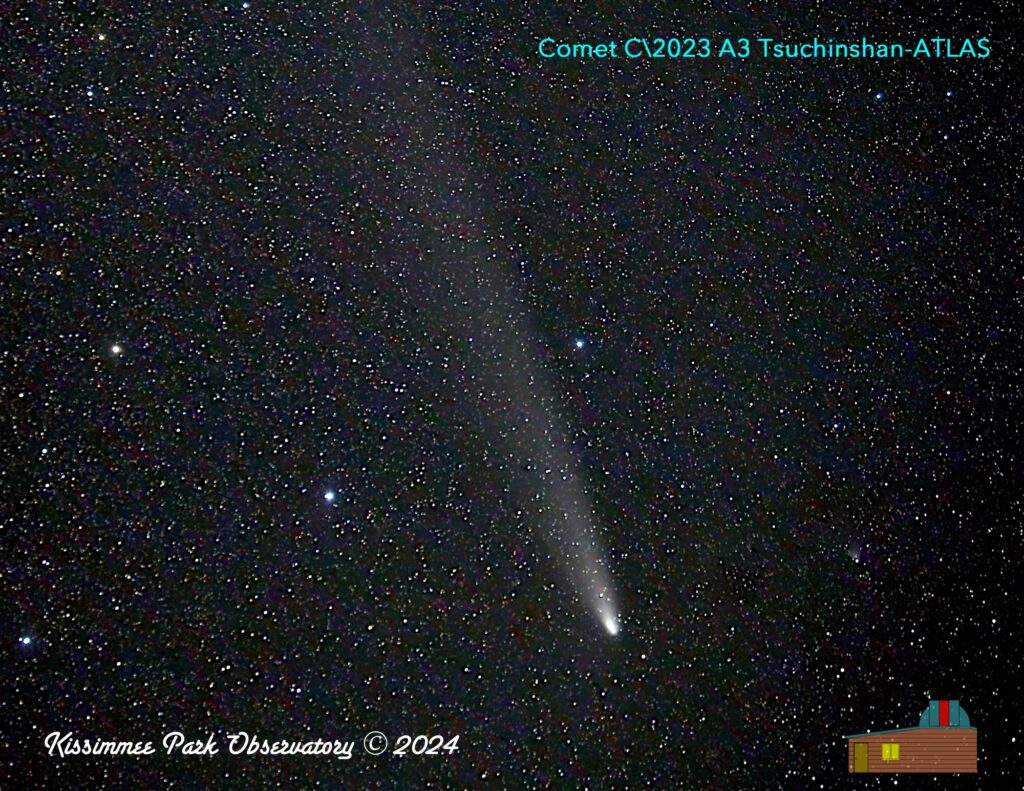
Comet C/2023 A3 Tsuchinshan-ATLAS on its way out. This image of the fading comet was taken from the Chiefland Astronomy Village. Total integration time of 82 minutes through a DSLR on a tracking mount.
The Cosmic Journey of Comet C/2023 A3 Tsuchinshan-ATLAS
As the comet known as C/2023 A3 (Tsuchinshan-ATLAS) swings past the sun and Earth, heading back into the vast expanse of the outer solar system, it leaves behind a trail of awe and scientific wonder. Here’s a look at its journey:
A Spectacle in the Inner Solar System
- Perihelion Passage: On September 27, 2024, Comet Tsuchinshan-ATLAS reached its perihelion, the closest point to the sun in its orbit, at a distance of approximately 0.39 astronomical units (AU). This event was anticipated with excitement, as comets often become spectacularly bright when close to the sun due to the heating of their icy surfaces, leading to the sublimation of ice into gas and the creation of a luminous coma and tails.
- Visible from Earth: Following its perihelion, the comet became a notable sight in our night skies. On October 12, 2024, it made its closest approach to Earth at about 0.47 AU, making it visible to the naked eye. Observers around the globe, particularly in the Northern Hemisphere, were treated to a celestial show where the comet’s tail stretched dramatically across the sky, with some reports suggesting it reached lengths of over 20 degrees. This visibility was enhanced by the phenomenon known as forward scattering, where sunlight is reflected directly towards Earth, brightening the comet significantly.
- A Rare Anti-Tail: A unique feature during its visit was the appearance of an anti-tail. This occurs when Earth passes through the comet’s orbital plane, making the dust tail appear to point towards the sun. This optical illusion provided photographers and astronomers with a rare opportunity to capture what looked like a ‘unicorn horn’ extending from the comet.
The Comet’s Journey Outward
- Leaving the Inner Solar System: Now, post its close encounter with the sun and Earth, Comet Tsuchinshan-ATLAS is on its journey back to the icy realms from whence it came. Its orbit, highly elliptical, takes it far beyond the orbits of the planets, possibly even out of the solar system itself if its trajectory is sufficiently hyperbolic.
- The Future of the Comet: With an estimated orbital period of around 80,660 years, this might have been its last visit to the inner solar system for tens of thousands of years, or perhaps forever. The gravitational influences of the planets could have altered its path, potentially ejecting it from our solar system. This comet’s future is uncertain, a testament to the chaotic beauty of celestial mechanics.
Scientific Insights and Public Fascination
- Understanding Comets: Each visit of a comet like Tsuchinshan-ATLAS provides scientists with valuable data. By studying its composition through spectroscopy, we learn more about the solar system’s formation, the materials present in the outer solar system, and how comets evolve as they approach the sun.
- Public Engagement: The comet’s passage sparked interest across the globe, with numerous citizen scientists and amateur astronomers capturing images and contributing to scientific databases. This event not only highlighted the beauty of our cosmic neighborhood but also encouraged public engagement with astronomy.
Captured Moments
Images captured by both professionals and amateurs have been shared widely, showing the comet’s tail against various landscapes, from the Dolomites in Italy to the starry skies above deserts and mountains. These images, often shared on social platforms like X, showcase not only the comet’s beauty but also humanity’s enduring fascination with the cosmos.
Final Words
Comet C/2023 A3 Tsuchinshan-ATLAS’s journey through the inner solar system was a reminder of the dynamic, ever-changing nature of our universe. As it heads back to the distant Oort Cloud or beyond, we are left with memories of its beauty and the opportunity to reflect on our place in the cosmos. Its passage was not just a visual treat but a moment for scientific inquiry and public wonder, linking us all in the shared experience of looking up at the stars.
Image Info
- Imaged from Chiefland Astronomy Village, Chiefland, FL (Bortle 4)
- Camera : Canon 6D
- Scope: Canon 100-400 F\5.6L lens, set at 200mm
- Mount: iOptron SkyGuider Pro (tracker)
- RGB: 41 subframes of 120s = 82 min integration = 1.4 hours.
- Automation through intervalometer
- Subframes stacked and RGB integrated in Astro Pixel Processor
- Image run through Super DeNoising
- Final processing in Aperture
